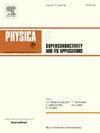Calculation and understanding of the nitrogen doping process in niobium for superconducting radio frequency accelerator
IF 1
3区 物理与天体物理
Q4 PHYSICS, APPLIED
Physica C-superconductivity and Its Applications
Pub Date : 2025-01-15
DOI:10.1016/j.physc.2024.1354616
引用次数: 0
Abstract
A computational model is developed to predict the nitrogen concentration profile within Nb utilized in superconducting radio-frequency (SRF) accelerators. This model incorporates variations in the sticking coefficient of nitrogen during the adsorption process on the Nb surface, along with the impact of nitride formation resulting from the reaction between Nb and nitrogen. The conclusions drawn from this model are compared with the outcomes of vertical test experiments. The computed results indicate that exhibiting a significant nitrogen doping effect is achieved when the nitrogen concentration is approximately 1E25 atom/m under various nitrogen doping recipes. This study enhances the understanding of the nitrogen doping process and enables the rapid determination of the optimal subsequent material removal thickness for various experimental recipes.

超导射频加速器用铌中氮掺杂过程的计算与认识
建立了一个计算模型来预测超导射频(SRF)加速器中铌内氮的浓度分布。该模型考虑了Nb表面吸附过程中氮的粘附系数的变化,以及Nb与氮反应生成氮化物的影响。并将所得结论与竖向试验结果进行了比较。计算结果表明,在不同的氮掺杂配方下,当氮浓度约为1E25原子/m3时,均表现出明显的氮掺杂效应。本研究增强了对氮掺杂过程的理解,并使各种实验配方的最佳后续材料去除厚度的快速确定成为可能。
本文章由计算机程序翻译,如有差异,请以英文原文为准。
求助全文
约1分钟内获得全文
求助全文
来源期刊
CiteScore
2.70
自引率
11.80%
发文量
102
审稿时长
66 days
期刊介绍:
Physica C (Superconductivity and its Applications) publishes peer-reviewed papers on novel developments in the field of superconductivity. Topics include discovery of new superconducting materials and elucidation of their mechanisms, physics of vortex matter, enhancement of critical properties of superconductors, identification of novel properties and processing methods that improve their performance and promote new routes to applications of superconductivity.
The main goal of the journal is to publish:
1. Papers that substantially increase the understanding of the fundamental aspects and mechanisms of superconductivity and vortex matter through theoretical and experimental methods.
2. Papers that report on novel physical properties and processing of materials that substantially enhance their critical performance.
3. Papers that promote new or improved routes to applications of superconductivity and/or superconducting materials, and proof-of-concept novel proto-type superconducting devices.
The editors of the journal will select papers that are well written and based on thorough research that provide truly novel insights.

 求助内容:
求助内容: 应助结果提醒方式:
应助结果提醒方式:


